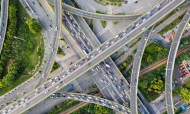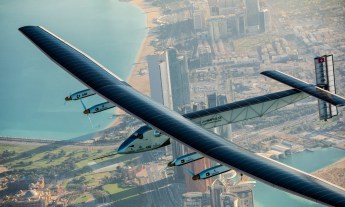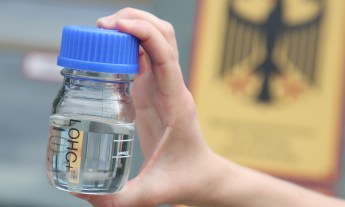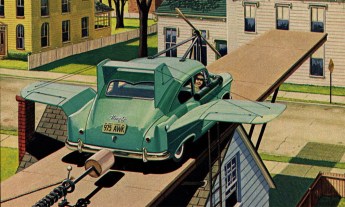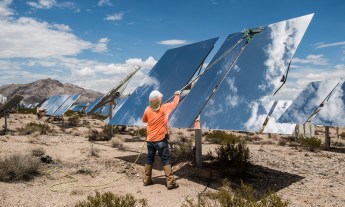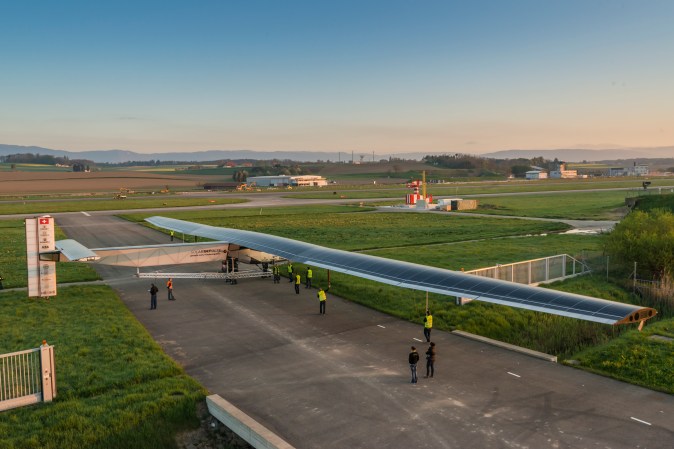
Bertrand Piccard plans to fly around the world in a plane that doesn’t use any fuel. Huh? Yep. This machine is equipped with 17,000 solar panels. He explains the logistics and mechanics — and shares some hopes and fears for the upcoming voyage.
Looks like 2015 will be a busy year for Bertrand Piccard. From March through August, the Swiss psychiatrist-turned-aeronautical-adventurer will fly around the world. The catch? He’ll be flying an airplane powered only by the sun. For up to six days straight, Piccard will journey as fast and far as he can. Then he’ll land and let fellow pilot André Borschberg take over. The pair will switch off in a journey that is expected to take six months, and will require the pilots to live in a cockpit that’s literally built for one.
Last month, Piccard unveiled the aircraft in which he and Borschberg will make their fuel-free journey. Solar Impulse 2 took 12 years to develop and test and is a strange-looking beast. The plane has a wingspan that’s bigger than that of a jumbo jet, with 17,000 solar panels built into it, yet the whole thing weighs only about as much as a car. We called Piccard to find out more about how the plane works and how he’s preparing for life on board. Below, an edited transcript of that conversation.
You spoke at TEDGlobal 2009 after you’d finished hot-air ballooning around the world. What got you from there to flying a fuel-less plane?
For the balloon flight, I used 3.7 tons of liquid propane. I landed with 40 kilos left — I could have only gone maybe two or three more hours. I realized that I had been completely dependent on fossil energy, and wanted to do something that would make me completely free from fossil energy. I wanted to stay in the air as long as I wished. That made me dream of a solar-powered airplane that could fly day and night and not be limited by quantity of fuel.
How does the Solar Impulse 2 work?
There are solar panels on the wings, on the fuselage and on the tail, and four electric motors that are each connected to a pack of batteries. When the sun is shining, your airplane flies, climbs to 27,000 feet, charges the batteries and runs the engine at the same time. During the night, you run on the batteries, and the next sunrise, you start to reload the batteries and continue your flight. Theoretically, your plane can fly forever.
It’s safe to say it’s pretty different from commercial flying?
I would say that the commercial airplane is at the end of a cycle that started 100 years ago. Solar Impulse is at the beginning of another cycle — the cycle of navigation with no fuel. We hope that there will be a revolution allowing solar-powered airplanes to fly faster, to fly in bad weather, to transport people also.
Are the solar panels on the wingspan the ones we already know and use?
Yes. All of the technologies we use on Solar Impulse are ones that people can buy. We are using the best solar panels available for houses, made by the American company SunPower. We have the best batteries — and people can buy those. People can buy the same electrical motors and put them in cars. They can use the same insulation material on their house to reduce their energy consumption. All of this has been developed for Solar Impulse, but it is now available for everybody.
We’re not just doing this for the fun of flying. We’re showing what can be achieved today with clean technologies. This is why I say that Solar Impulse is a clean project, not a green project. The green … it’s political, you know? We are not political. We say: let’s put clean technologies on the market and open new possibilities for everybody to have a better life.
“With perseverance, with courage, with pioneering spirit, you can achieve great things.”
And the plane can really fly forever?
It’s interesting — the plane can fly forever. What cannot fly forever is the pilot. The pilot is the weak part of the chain. This is why we plan to fly five to six days, and then the plane will land so we can change pilots. André Borschberg and myself will take turns in the single-seater cockpit, and we will fly like this around the world, with one or two stops on every continent.
What’s life on the plane like for those five or six days?
There is autopilot, so the flight can be very stable. The seats can recline to be completely flat, so the pilot can rest and do physical exercises. There is food, oxygen and water for one week. There’s a basic kitchen, so you use that. There are toilets on board. You fly about 1,000 miles per day.
How are you getting ready for the psychological challenge of being in such a small space for days at a time?
This is about passion. André and I have been working on this project now for 11 years, which means that we are really looking forward to the climax. We will not complain if we are alone for five days, because it’s really what we’ve been wanting to do for a very long time now.
Have you trained like astronauts?
It’s not exactly the same training, because astronauts have to train for zero gravity and we have gravity. But we train, for example, in the flight simulator for 72 hours. We learned meditation techniques — how to relax and to rest, how to do self-hypnosis. We learned how to work with the ergonomics of the cockpit — how to get physical exercise and attend to any medical needs. We do have a medical team. So yeah, it’s a lot of training. We also train to survive in the water — we learned how to inflate a life raft, jump with a parachute, all these types of things. So we’re really ready. We are explorers; we are not daredevils.
What worries you about the flight?
The biggest fear is of course that we find ourselves over the Pacific or Atlantic Ocean with weather that has changed from the forecast, and that we cannot continue the flight. I worry that we have to bail out in the middle of the Pacific or the Atlantic and wait on the life raft, because it could be several days before people found us. That’s a little frightening. But it’s part of the adventure. We need to be ready for that.
How do you feel that the project has evolved and grown since you introduced it to the TED community in 2009?
When I gave that talk, Solar Impulse 1 had not flown at all yet. And now, not only do we have Solar Impulse 2 almost ready, but we have flown Solar Impulse 1 across Europe, across the Mediterranean and across the United States. It really shows that if you have a dream, you have to wait to make it come true. With perseverance, with courage, with pioneering spirit, you can achieve great things. I think that’s the main message of what we’re doing. We have the message about clean technologies and renewable energies and protecting the environment, but we also want to encourage people to fulfill their dreams. To get out of habits that keep them a prisoner of old ways of thinking. We need to be able to project ourselves into the unknown to stimulate our creativity, and leave question marks and doubts behind in order to be more potent and more efficient in life. This is what Solar Impulse is about.
[ted id=723]
Top photo: The first outdoor technical tests of the Solar Impulse 2 took place in April 2014. Photo: Jean Revillard/Solar Impulse.


